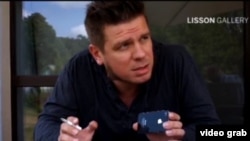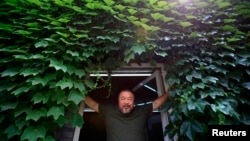Petro Wodkins, a Russian-born conceptual artist, first gained attention with projects like Armani Diapers, a fake advertising campaign meant to trick fashion-conscious mothers into spending $30 for a single black baby diaper emblazoned with the Giorgio Armani label.
This time around, Wodkins is taking aim at the $60 billion global art market -- by posing as a personal shopper for Tajik President Emomali Rahmon.
Identifying himself as "Petr Fomin," Wodkins spent more than three months in talks with prestigious London-based art galleries saying his "client," the 60-year-old Tajik leader, was ready to spend millions to present his daughter with a private collection of the best in contemporary art, including works by Damien Hirst, Andreas Gursky, and Ai Weiwei.
Dimitri Koyote, a spokesman for Wodkins, says the project was meant to explore the line between "morality and business" in global art sales, and that using a moneyed Central Asian autocrat was all part of the plan.
"Petro thought Tajikistan was a good option," Koyote says. "It's a comparatively poor country, Rahmon is very, very rich, and the corruption there is enormous. So for an outsider it's a rather credible story to have it be Tajikistan."
Emerging Markets
Of the 10 galleries that engaged in talks with Wodkins, who secretly recorded the conversations, few of the dealers appeared to have any more than a basic recognition of Tajikistan or Rahmon. (A broker at the Hamiltons photography gallery, at least passingly familiar with the true source of power in Central Asia, queries, "Is he the president of the country, or the president of the oil company in the country?")
But the notion of a obscure post-Soviet leader looking to spend millions on art is no longer an eyebrow-raiser in London, where galleries and auction houses like Sotheby's now regularly cater to enthusiasts like Azerbaijani first lady Mehriban Aliyeva and a coterie of Russian and Kazakh oligarchs, who see art as a solid, legitimizing investment.
Tajikistan, of course, is no Russia or Kazakhstan. With no petro-resources and scarce mineral wealth, it is the poorest country in Central Asia. But Rahmon, an entrenched autocrat whose powerful family is suspected of widespread graft, has a personal fortune estimated in the hundreds of millions.
Among the pieces reportedly discussed were Gursky's "Kuwait Stock Exchange," with a selling price of $2 million; a work by French-American sculptor Louise Bourgeois priced at $3.5 million; a $1.5-million piece by Hirst; and "Feet," an installation by Ai valued at $755,000.
Secret Deals
Throughout the negotiations, Wodkins -- who this week is releasing "The Price of Art," a 15-minute film based on his recordings -- stressed the importance of keeping the purchases confidential.
Posing as "Fomin," he repeatedly explained that absolute secrecy was needed to avoid inflaming anger among impoverished Tajiks who would resent such massive expenditures by their corrupt president.
In nearly all cases the sellers -- all from respected galleries, including Hamiltons, White Cube, and Blain Southern -- were eager to oblige, casually offering the possibility of shell companies and offshore accounts to avoid a direct connection to Rahmon.
In one Skype conversation with a young Blain Southern representative, "Fomin" says Rahmon's name must be kept out of any paperwork.
"Otherwise, my customer will have big problems back home in his country because people are kind of poor," he says. "They won't really be happy when they make, I don't know, $10 a month and he buys $1 million in artwork for his kids."
"No, I understand," the seller says, nodding sympathetically. "And it's not the first time that we do these kinds of things, so I'm completely with you."
'Shocking' Secrecy
Rahmon's abysmal human rights reputation appeared to have almost no bearing on Wodkins' negotiations, even when it came to Ai, a noted political activist who has openly criticized the Chinese government's stance on democracy and human rights.
Koyote says most of the galleries impressed upon Wodkins that they had the full trust of the artists they represented and that in some instances the artist might never need to know the identity of a client. (There is no indication that any of the artists were ever informed about the potential sales.)
Only one gallery, Waddington Custot, backed out of the talks altogether after being informed about the need for secrecy. Several of the other galleries have since defended their actions, saying the negotiations with "Fomin" were only in the early stages and that both Rahmon and his terms would have come under greater scrutiny with time.
Rahmon, the unwitting subject of Wodkins' project, has yet to respond to the hoax, which was first reported by Britain's "Sunday Times" on September 29. But the story has sent a ripple of shock through some members of the British art world.
"I'm actually riveted by this because it just shows how opaque the whole process is, even more opaque than I thought," says Georgina Adam, a London-based journalist who has written about what she calls the global art market's "culture of secrecy" in "The Art Newspaper."
"I think what surprised me and shocked me was when the salesperson says, 'I completely understand. It's not the first time we do these kinds of things, I'm completely with you.' You know, it's a salesperson, but I think it is very shocking all the same," Adam adds.
Selling Or Selling Out?
To some, the sale of high-priced art to corrupt post-Soviet leaders may seem no different than performance artists like Jennifer Lopez and Kanye West accepting millions to perform in Turkmenistan or Kazakhstan.
But Koyote says art should play a different role, and that Wodkins' project shows that galleries are willing to set their artists' reputations aside when there are millions to be made.
"It kind of exposes the ugly business side to art," he says. "The art dealers are almost more in control of creating artists than the artists themselves. And to expose this is, of course, very embarrassing for the art dealers. This and also the fact that they are willing to sell artworks -- especially like Ai Weiwei -- to a dictator. I think it's very bad for them."
This time around, Wodkins is taking aim at the $60 billion global art market -- by posing as a personal shopper for Tajik President Emomali Rahmon.
Identifying himself as "Petr Fomin," Wodkins spent more than three months in talks with prestigious London-based art galleries saying his "client," the 60-year-old Tajik leader, was ready to spend millions to present his daughter with a private collection of the best in contemporary art, including works by Damien Hirst, Andreas Gursky, and Ai Weiwei.
Dimitri Koyote, a spokesman for Wodkins, says the project was meant to explore the line between "morality and business" in global art sales, and that using a moneyed Central Asian autocrat was all part of the plan.
"Petro thought Tajikistan was a good option," Koyote says. "It's a comparatively poor country, Rahmon is very, very rich, and the corruption there is enormous. So for an outsider it's a rather credible story to have it be Tajikistan."
Emerging Markets
Of the 10 galleries that engaged in talks with Wodkins, who secretly recorded the conversations, few of the dealers appeared to have any more than a basic recognition of Tajikistan or Rahmon. (A broker at the Hamiltons photography gallery, at least passingly familiar with the true source of power in Central Asia, queries, "Is he the president of the country, or the president of the oil company in the country?")
But the notion of a obscure post-Soviet leader looking to spend millions on art is no longer an eyebrow-raiser in London, where galleries and auction houses like Sotheby's now regularly cater to enthusiasts like Azerbaijani first lady Mehriban Aliyeva and a coterie of Russian and Kazakh oligarchs, who see art as a solid, legitimizing investment.
Tajikistan, of course, is no Russia or Kazakhstan. With no petro-resources and scarce mineral wealth, it is the poorest country in Central Asia. But Rahmon, an entrenched autocrat whose powerful family is suspected of widespread graft, has a personal fortune estimated in the hundreds of millions.
Among the pieces reportedly discussed were Gursky's "Kuwait Stock Exchange," with a selling price of $2 million; a work by French-American sculptor Louise Bourgeois priced at $3.5 million; a $1.5-million piece by Hirst; and "Feet," an installation by Ai valued at $755,000.
Secret Deals
Throughout the negotiations, Wodkins -- who this week is releasing "The Price of Art," a 15-minute film based on his recordings -- stressed the importance of keeping the purchases confidential.
Posing as "Fomin," he repeatedly explained that absolute secrecy was needed to avoid inflaming anger among impoverished Tajiks who would resent such massive expenditures by their corrupt president.
In nearly all cases the sellers -- all from respected galleries, including Hamiltons, White Cube, and Blain Southern -- were eager to oblige, casually offering the possibility of shell companies and offshore accounts to avoid a direct connection to Rahmon.
In one Skype conversation with a young Blain Southern representative, "Fomin" says Rahmon's name must be kept out of any paperwork.
"Otherwise, my customer will have big problems back home in his country because people are kind of poor," he says. "They won't really be happy when they make, I don't know, $10 a month and he buys $1 million in artwork for his kids."
"No, I understand," the seller says, nodding sympathetically. "And it's not the first time that we do these kinds of things, so I'm completely with you."
'Shocking' Secrecy
Rahmon's abysmal human rights reputation appeared to have almost no bearing on Wodkins' negotiations, even when it came to Ai, a noted political activist who has openly criticized the Chinese government's stance on democracy and human rights.
Koyote says most of the galleries impressed upon Wodkins that they had the full trust of the artists they represented and that in some instances the artist might never need to know the identity of a client. (There is no indication that any of the artists were ever informed about the potential sales.)
Only one gallery, Waddington Custot, backed out of the talks altogether after being informed about the need for secrecy. Several of the other galleries have since defended their actions, saying the negotiations with "Fomin" were only in the early stages and that both Rahmon and his terms would have come under greater scrutiny with time.
Rahmon, the unwitting subject of Wodkins' project, has yet to respond to the hoax, which was first reported by Britain's "Sunday Times" on September 29. But the story has sent a ripple of shock through some members of the British art world.
"I'm actually riveted by this because it just shows how opaque the whole process is, even more opaque than I thought," says Georgina Adam, a London-based journalist who has written about what she calls the global art market's "culture of secrecy" in "The Art Newspaper."
"I think what surprised me and shocked me was when the salesperson says, 'I completely understand. It's not the first time we do these kinds of things, I'm completely with you.' You know, it's a salesperson, but I think it is very shocking all the same," Adam adds.
Selling Or Selling Out?
To some, the sale of high-priced art to corrupt post-Soviet leaders may seem no different than performance artists like Jennifer Lopez and Kanye West accepting millions to perform in Turkmenistan or Kazakhstan.
But Koyote says art should play a different role, and that Wodkins' project shows that galleries are willing to set their artists' reputations aside when there are millions to be made.
"It kind of exposes the ugly business side to art," he says. "The art dealers are almost more in control of creating artists than the artists themselves. And to expose this is, of course, very embarrassing for the art dealers. This and also the fact that they are willing to sell artworks -- especially like Ai Weiwei -- to a dictator. I think it's very bad for them."













